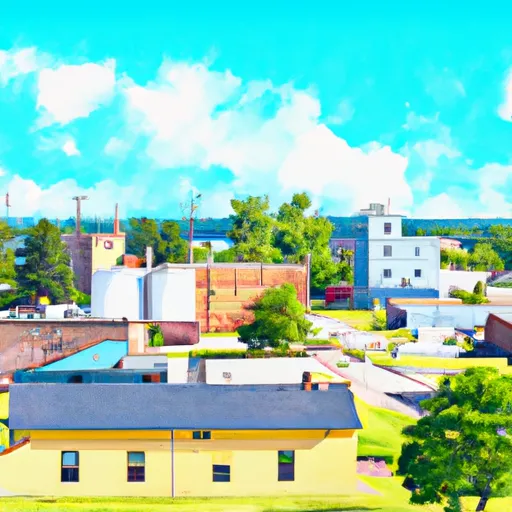-
 Snoflo Premium
Snoflo Premium
Get unlimited access to all our content
With no Ad interruptions! - Start Your Free Trial Login with existing account
Stoddard
Eden Index
Climate
6.6
•
Recreation
3.2
•
Community
1.1
•
Safeguard
4.0/10

Stoddard is a small village located in Vernon County, Wisconsin. It is situated in the Driftless Area, known for its unique topography unaffected by the last glacial period. Stoddard experiences a humid continental climate, characterized by warm summers and cold winters. Average temperatures range from around 20°F (-6.7°C) in winter to 80°F (26.7°C) in summer. Precipitation is evenly distributed throughout the year, with an annual average of around 35 inches (89 cm).
The village of Stoddard is positioned along the Mississippi River, offering beautiful views and recreational opportunities. The hydrology constituents in the area primarily revolve around the Mississippi River, with its tributaries providing excellent fishing for various species such as walleye, bass, and catfish. Boating and canoeing are also popular activities, allowing visitors to explore the scenic waterways and enjoy the abundant wildlife.
Stoddard is surrounded by lush forests and rolling hills, making it a great destination for outdoor enthusiasts. The village is located near several state parks and nature reserves, providing ample opportunities for hiking, camping, bird watching, and wildlife photography. Activities like hunting, horseback riding, and ATV trail riding are also available in the surrounding area. Overall, Stoddard offers a picturesque setting and a range of outdoor recreational activities for visitors to enjoy.
What is the Eden Index?
The Snoflo Eden Index serves as a comprehensive rating system for regions, evaluating their desirability through a holistic assessment of climate health, outdoor recreation opportunities, and natural disaster risk, acknowledging the profound impact of these factors on livability and well-being.
Climate Health Indicator (CHI): 6.6
Stoddard receives approximately
883mm of rain per year,
with humidity levels near 82%
and air temperatures averaging around
8°C.
Stoddard has a plant hardyness factor of
4, meaning
plants and agriculture in this region thrive during a short period during spring and early summer. Most
plants will die off during the colder winter months.
By considering the ideal temperature range, reliable water supplies, clean air, and stable seasonal rain or snowpacks, the Climate Health Indicator (CHI) underscores the significance of a healthy climate as the foundation for quality living.
A healthy climate is paramount for ensuring a high quality of life and livability in a region, fostering both physical well-being and environmental harmony. This can be characterized by ideal temperatures, reliable access to water supplies, clean air, and consistent seasonal rain or snowpacks.
Weather Forecast
Streamflow Conditions
Upper Mississippi-Maquoketa-Plum
Area Rivers
Upper Mississippi-Maquoketa-Plum
Snowpack Depths
Upper Mississippi-Maquoketa-Plum
Reservoir Storage Capacity
Upper Mississippi-Maquoketa-Plum
Groundwater Levels
Recreational Opportunity Index (ROI): 3.2
The Recreational Opportunity Index (ROI) recognizes the value of outdoor recreational options, such as parks, hiking trails, camping sites, and fishing spots, while acknowledging that climate plays a pivotal role in ensuring the comfort and consistency of these experiences.
Access to outdoor recreational opportunities, encompassing activities such as parks, hiking, camping, and fishing, is crucial for overall well-being, and the climate plays a pivotal role in enabling and enhancing these experiences, ensuring that individuals can engage in nature-based activities comfortably and consistently.
Camping Areas
| Campground | Campsites | Reservations | Toilets | Showers | Elevation |
|---|---|---|---|---|---|
| Great River Road State Park | None | 150 ft | |||
| Meramec State Park | None | 613 ft | |||
| Riverfront RV Park | None | 178 ft | |||
| Greer Crossing | 72 | 564 ft | |||
| Lake Chicot State Park | None | 128 ft | |||
| Notrebes Bend | None | 160 ft | |||
| Merrisach Lake Park - Merrisach Lake | None | 169 ft | |||
| Warfield Point Park | None | 132 ft | |||
| Wilbur D Mills | None | 188 ft | |||
| Pendleton Bend | None | 172 ft |
Nearby Ski Areas
Catastrophe Safeguard Index (CSI):
The Catastrophe Safeguard Index (CSI) recognizes that natural disaster risk, encompassing floods, fires, hurricanes, and tornadoes, can drastically affect safety and the overall appeal of an area.
The level of natural disaster risk in a region significantly affects safety and the overall livability, with climate change amplifying these risks by potentially increasing the frequency and intensity of events like floods, fires, hurricanes, and tornadoes, thereby posing substantial challenges to community resilience and well-being.
Community Resilience Indicator (CRI): 1.1
The Community Resilience Indicator (CRI) recognizes that education, healthcare, and socioeconomics are crucial to the well-being of a region. The CRI acknowledges the profound impact of these elements on residents' overall quality of life. By evaluating educational resources, healthcare accessibility, and economic inclusivity, the index captures the essential aspects that contribute to a thriving community, fostering resident satisfaction, equity, and social cohesion.

